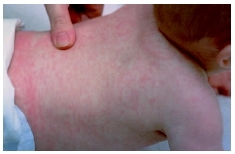Roseola
Definition
Roseola is a common disease of babies or young children, in which several days of very high fever are followed by a characteristic rash.
Demographics
Roseola is an extraordinarily common infection, caused by a virus. About 90 percent of all children have been exposed to the virus, with about 33 percent actually demonstrating the syndrome of fever followed by rash.
The most common age for a child to contract roseola is between six and twelve months. Roseola infection strikes boys and girls equally. The infection may occur at any time of year, although late spring and early summer seem to be peak times for it.

Causes and symptoms
About 85 percent of the time, roseola is caused by a virus called human herpesvirus 6 (HHV-6). Although the virus is related to those herpesviruses known to cause sores on the lips or genitalia, HHV-6 causes a very different type of infection. HHV-6 is believed to be passed between people via infected saliva. A few other viruses (called enteroviruses) can produce a similar fever-then-rash illness, which is usually also called roseola.
Researchers believe that it takes about five to 15 days to develop illness after having been infected by HHV-6. Roseola strikes suddenly, when a previously well child spikes an impressively high fever. The temperature may reach 106°F (41°C) . As is always the case with sudden fever spikes, the extreme change in temperature may cause certain children to have seizures. About 5 to 35 percent of all children with roseola have febrile seizures .
The most notable thing about this early phase of roseola is the absence of symptoms, other than the high fever. Although some children have a slightly reddened throat or a slightly runny nose, most children have no symptoms whatsoever, other than the sudden development of high fever. This fever lasts for between three and five days.
Somewhere around the fifth day, a rash begins on the body. The rash is usually composed of flat pink patches or spots, although there may be some raised patches as well. The rash usually starts on the chest, back, and abdomen then spreads out to the arms and neck. It may or may not reach the legs and face. The rash lasts for about three days then fades.
Very rarely, roseola causes more serious disease. Patients so afflicted experience significant swelling of the lymph nodes, the liver, and the spleen. The liver may become sufficiently inflamed to interfere with its functioning, resulting in a yellowish color to the whites of the eyes and the skin ( jaundice ). This syndrome (called a mononucleosis-like syndrome, after the disease mononucleosis that causes many of the same symptoms) has occurred in both infants and adults.
Diagnosis
The diagnosis of roseola is often made by carefully examining the feverish child to make sure that other illnesses are not causing the temperature spike. Once it is clear that no pneumonia , ear infection, strep throat , or other common childhood illness is present, the practitioner usually feels comfortable waiting to see if the characteristic rash of roseola begins.
Treatment
As of 2004, there were no treatments available to stop the course of roseola. Acetaminophen or ibuprofen is usually given to try to lower the fever. Children who are susceptible to seizures may be given a sedative medication when the fever first spikes in an attempt to prevent such a seizure.
Prognosis
Children recover quickly and completely from roseola. The only complications are those associated with seizures or the rare mononucleosis-like syndrome.
KEY TERMS
Jaundice —A condition in which the skin and whites of the eyes take on a yellowish color due to an increase of bilirubin (a compound produced by the liver) in the blood. Also called icterus.
Mononucleosis —An infection, caused by the Epstein-Barr virus, that causes swelling of lymph nodes, spleen, and liver, usually accompanied by extremely sore throat, fever, headache, and intense long-lasting fatigue. Also called infectious mononucleosis.
Prevention
Other than the usual good hygiene practices always recommended to decrease the spread of viral illness, no methods as of 2004 are available to specifically prevent roseola.
Parental concerns
Roseola is usually a benign illness, from which the child recovers uneventfully. One of the more major potential complications is the development of febrile seizures secondary to the rapid, high rise in fever. Rare cases of encephalitis or meningoencephalitis have also been reported.
Resources
BOOKS
Hall, Caroline Breese. "Human Herpesviruses 6 and 7 (Roseola, Exanthem Subitum)." In Principles and Practice of Pediatric Infectious Diseases , 2nd ed. Edited by Sarah S. Long et al. St. Louis, MO: Elsevier, 2003.
Leach, Charles T. "Roseola (Human Herpesviruses 6 and 7)." In Nelson Textbook of Pediatrics. Edited by Richard E. Behrman et al. Philadelphia: Saunders, 2004.
Rosalyn Carson-DeWitt, MD
Comment about this article, ask questions, or add new information about this topic: